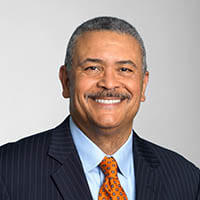September 03, 2021
By Daniel H. Gillison

The fall was always an exciting time for my family. My wife, Barbara, who was an educator for 30 years, would prepare to welcome a new set of sixth grade students for the upcoming school year. My kids would take first-day-of-school pictures, and I would drop them off at their new classrooms.
Occasionally, when my daughter was in middle school, I would pick up McDonald’s french fries and bring them over to her school cafeteria to share with her and her friends. And I’ll never forget the emotions felt when I dropped off each of my kids for their first year of college — the pride, excitement and anticipation of new independence, growth, adventures and friendships to be had.
But going back to school is different this year for most students, caregivers and educators after more than a year of virtual learning due to COVID-19.
The cafeterias and classrooms look different with social distancing protocols and some mask mandates still in place. The in-services for teachers look different, as safety measures are updated on what feels like a daily basis. The worries surrounding back-to-school as a whole look different, as caregivers hope that their children will not only make good choices and study hard, but also remain physically safe as the Delta variant continues to surge across the country.
The challenges we face this year are unlike anything we have had to navigate before. And as we take precautions to guard our physical health, we must also ensure that we continue to protect our mental health. Here are a few helpful tips for navigating the transition:
Many are excited to return to the in-person environment after a year of virtual classrooms. Students are eager to see their friends, go to school sports events and participate in clubs and extracurricular activities. Caregivers are excited to return to their professional lives without the added task of homeschooling their children. And teachers are excited to be back in an environment where they know how to teach and engage with students best.
But many are feeling other emotions as well.
Some students experienced difficult home situations during the lockdowns of last year and may continue to be wrestling with the repercussions of that instability. Some are anxious about having fallen behind their peers during virtual learning. Some are stressed about staying healthy at school this fall as they begin to see people in person again. Some are afraid that schools will be shut down again and they will have to return to the virtual environment as new variants of the virus continue to emerge. Some are exhausted from having to continue dealing with the pandemic at all. And many are continuing to grieve, in one way or another, the many losses endured over the last year, as more than 600,000 people in the U.S. have died due to COVID-19, and approximately 43,000 children have lost a parent.
Whether you are feeling excited, afraid, sad or anxious, all of these emotions are reasonable reactions to this year’s unique circumstances. It’s important to remember that whatever you, your student, your child or your family members are feeling is ok. You may feel many different emotions at once — even seemingly contradictory emotions — and that’s ok too. You can be both happy and sad, both excited and anxious, both relieved and afraid.
Try your best not to place judgment on these emotions. After all, thoughts and feelings are like coiled springs: the more you try to push them down, the more they tend to bounce back up. Instead of trying to get rid of or change any unpleasant emotions, simply acknowledge them — write them down, say them out loud — and accept them.
Acknowledging and accepting your emotions can be extremely helpful in coping with difficult feelings. Talking about what you’re feeling with others can help too.
This year hasn’t been easy for anyone, and many appreciate having the space to talk about it. Meaningful connection with others is critical after more than a year of social isolation and massive shifts in normal routines. Checking in with those around you doesn’t have to be intimidating.
Simply make an intentional effort to ask how those around you are doing — whether those are your friends, your students, your colleagues or your family members. And, in return, be honest about how you are doing. By normalizing these conversations and modeling vulnerability, you can reduce stigma and help others feel more comfortable sharing.
Change is inevitable, but that doesn’t mean it is easy.
As much as we are all craving a return to normalcy, we must reframe our thinking to instead embrace a new normal. The world has changed, but with change comes new opportunity. So ask yourself, what are the positives of the new situation you are finding yourself in? How can you create a “new normal” that is even better than the old one?
One of the biggest opportunities we have right now is to continue bringing mental health to the forefront of our conversations within academia and beyond. After all, 17% of youth (ages 6-17) experience a mental health disorder, with half of all mental health disorders beginning in individuals’ mid-teen years and 75% of mental health conditions presenting by age 25. Because of the new attention to both physical and mental health spurred by the pandemic, we have new opportunities to develop more mental health training for educators, to provide more resources for students and to facilitate more conversations with our loved ones.
As we prepare for a new school year, we are also preparing for a new normal; and mental health is more important now than ever. Remember to acknowledge the many emotions you, your students, your loved ones or your colleagues may be experiencing; normalize the conversation around mental health with those around you; and look for new opportunities as we navigate this unique time. This year, may we each be proactive not only in our pursuit toward academic excellence, but also in our pursuit toward our mental, physical, emotional, spiritual and communal health.
Back to School Mental Health Resources:
 Daniel H. Gillison, Jr. is the chief executive officer of NAMI (National Alliance on Mental Illness). Prior to his work at NAMI, he served as executive director of the American Psychiatric Association Foundation (APAF) in addition to several other leadership roles at various large corporations such as Xerox, Nextel, and Sprint. He is passionate about making inclusive, culturally competent mental health resources available to all people, spending time with his family, and of course playing tennis. You can follow him on Twitter at @DanGillison.
Daniel H. Gillison, Jr. is the chief executive officer of NAMI (National Alliance on Mental Illness). Prior to his work at NAMI, he served as executive director of the American Psychiatric Association Foundation (APAF) in addition to several other leadership roles at various large corporations such as Xerox, Nextel, and Sprint. He is passionate about making inclusive, culturally competent mental health resources available to all people, spending time with his family, and of course playing tennis. You can follow him on Twitter at @DanGillison.
We’re always accepting submissions to the NAMI Blog! We feature the latest research, stories of recovery, ways to end stigma and strategies for living well with mental illness. Most importantly: We feature your voices.
LEARN MORENAMI HelpLine is available M-F, 10 a.m. – 10 p.m. ET. Call 800-950-6264,
text “helpline” to 62640, or chat online. In a crisis, call or text 988 (24/7).